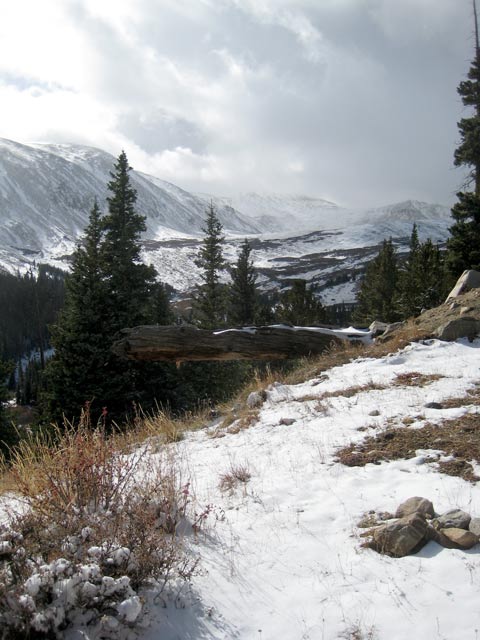
It’s mid October and it just keeps snowing here at 11,000 feet in Colorado’s high country. You’d think foraging season were over, but it’s not.
Two days ago I awoke to a steady snow and found myself unable to focus on work. By noon it stopped but the wind kicked up; the way it whipped around the house inspired Gregg to curl up by the fire and swear he’d stay inside all day. I felt exactly the opposite, however: I needed to go outside.
It’s hunting season so the hand-me-down pink bell bottom corduroys and orange puffy vest were in order. It was hat and gloves weather too with all that wind.
The mining road was vacant and the snow plentiful. I reveled in getting fresh tracks as I hiked through 3-4-inch-deep swaths of powder. At a switchback I clambered over the fallen tree trunk that obscures the footpath to the secret meadow, which I descended, brushing snow off the low bushes as I went.
There were many non-producing low juniper shrubs en route but eventually I found the one I was looking for, which I’d spied a few days prior. It is the most fruitful creeping juniper (Juniperus communis) shrub I’ve ever found, and despite the snow it was still laden with plump, blue berries.
Juniper “Berries” for Bizarre Beverages
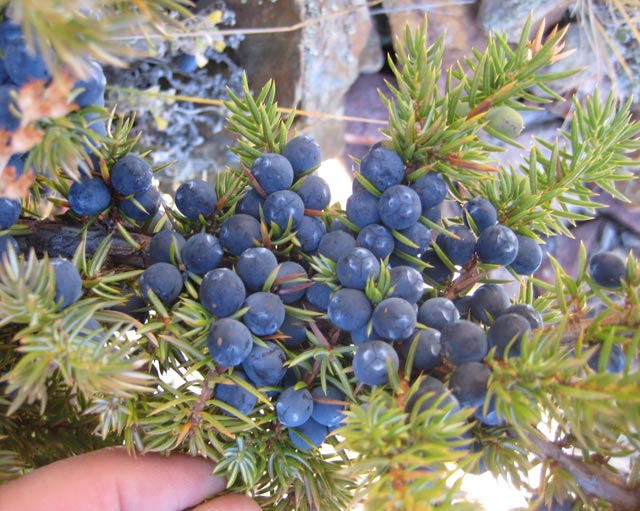
The so-called juniper “berries” are distinctive for their gin-like aroma, as they are its key ingredient. Some authors say they are mildly toxic and not to be consumed in quantity—but they’re so strong I couldn’t imagine eating many in one sitting anyway. Instead, they are used as a seasoning for sauerkraut, meats, and stews in addition to gin.
There are approximately 60 species of juniper in North America. From tall tree to creeping shrub, the plant is ubiquitous, its most telling feature the gin-smelling blue to bluish berries. These “berries” are not actually berries at all but instead female cones that reach maturity in their second year.
Taste varies from species to species. It can also vary from plant to plant, which is why it makes sense to field-taste prior to foraging. J. communis my favorite to date.
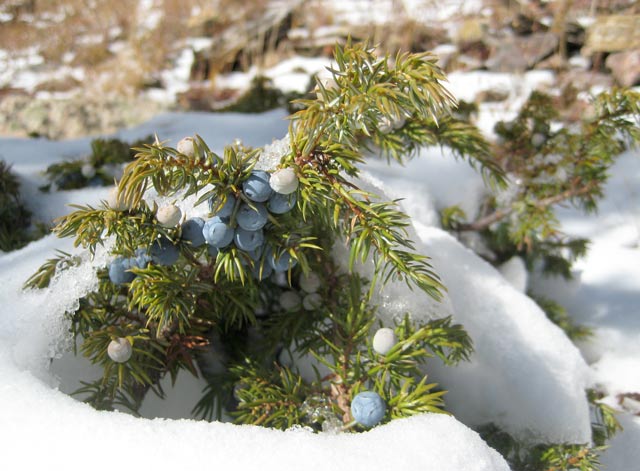
Snow-Foraged Syrup
Over the past year I’ve turned several bottles of cheap vodka into gin with juniper “berries,” sometimes in combination with other botanicals. Commenter Ellen left this thought on my post regarding it: “What I want to do is make a strong juniper-flavored syrup or tincture, to flavor soda. I love a good G&T, but sometimes I just want that wonderful flavor to quench my thirst. After a hot day in the sun, nothing is more refreshing, but it can make my head spin. So I wanted to flavor my tonic water with juniper for a non-alcoholic G&T soda for those days when head spinniness is not optimal.”
I’d wanted to make juniper syrup ever since.
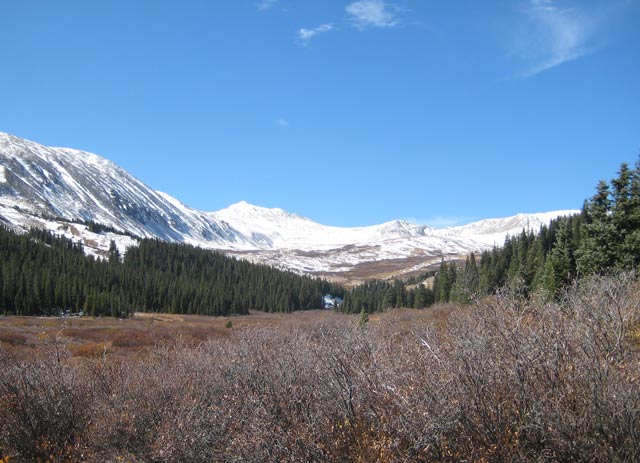
Out on the snowy slope under blazing white peaks towering over the autumn-colored valley, I gathered a ½ pint of the plump, blue berries. I tucked them into my backpack and my cold hands into my gloves, perched on the steep fallen trunk of a bristlecone, and let the wind buffet me, thinking how much I love winter. The clouds cleared to permit the sun’s rays and a bright blue sky for a meditative moment; when they blew back over again I returned home to simmer my berries.
For the syrup I added enough water to cover and heated on low for a bit, crushing the berries with a meat tenderizer as I went, then strained to extract the “essence” before adding an equal part sugar to the liquid and voila—juniper cocktail syrup!
Lacking tonic or seltzer I tried the creation with the dregs of my homemade gin on crushed ice. Both Gregg and I found “gin and juniper liquor” to be sweet and good, albeit unusual. Then I tried to be adventurous and added some syrup to a glass of scotch whiskey and water over ice. That was a fail. But later, when I did purchase some tonic water, the resultant Virgin & Tonic was indeed a hit.
Anyway, juniper is good for flavoring things. It is in season right now where I live and quite possibly where you live too. The nice thing is that even in a national forest, a person can gather so little as to be considered “incidental use,” but still have enough to flavor a dish or three.
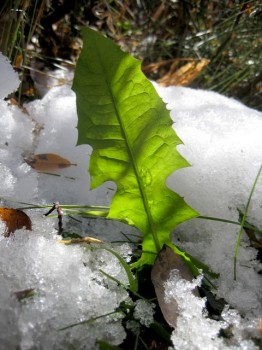
Dandelions Under Snow
Other recent snow-forage we’ve found in the Colorado high country includes dandelions, currants, and gooseberries.
We found the dandelion greens poking out of snow from grassy beds under willows along the same mining road. Some were as long as my arm!
I took a small bag and they almost wilted by the time I got home so I washed and ran them through the food processor immediately. The chopped greens smell exactly like a fresh mowed lawn—which, instead of off-putting, is a smell we treasure, as we don’t get much of it in these parts. To this I added finely chopped raw onions, oil, soy sauce, and tofu cubes for a batch of the cold marinated salad that has become my go-to dandelion recipe. Yum!
Currant & Gooseberry Vinaigrette
I had also hoped for and was tickled to find a few remaining spiny, red, high-bush currants (Ribes montigenum) and spinier purple gooseberries (Ribes inerme) dangling from their bare branches. The latter are very sour but make for good flavoring.
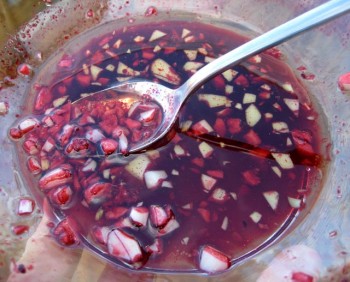
Although both Ribes species bore berries that were by that point fairly fermented, and although the gooseberries stabbed me repeatedly, stained my fingers the color of blood, and induced itching, I gathered maybe 1/5 of a pint combined, then returned home to transform them into currant & gooseberry vinaigrette.
To make the salad dressing, I washed and simmered the berries (without bothering to remove the mixed-in leaves and detritus) with just enough water to cover for a couple of minutes, crushing the berries with the meat tenderizer as I went. After cooking them down on low temperature, I strained, pressed out the juicy essence, sweetened that and mixed it with oil, vinegar, and fine-chopped garlic. This I served on a green salad topped with tofu cubes, which turned hot pink upon application of the salad dressing.
I imagine this berry vinaigrette technique would work well with many different kinds of berries. Last week I made a huckleberry vinaigrette to die for, and rose hips are next up.
It’s Just Frozen Water
Snow. It’s just frozen water. It’s not keeping me from my foraging—and I hope it won’t keep you from yours!
Updated 3.2.21

That first picture is breathtaking!
Juniper is really tasty with squirrel, btw.
we are very jealous of your great photo of the juniper bounty. In the ny city region…difficult to get communis do you know any places?…..but virginiana is good….although stronger in flavor…have you compared them side by side?
@tama: No, I haven’t compared them side by side, nor do I know an NYC area location to forage them, but I’ll definitely look next time I’m out east. I’d like to try the two side by side…. Have you ever taken a foraging hike with “Wildman” Steve Brill in the NYC area? I haven’t but have always wanted to.
I have not gone on a hike with wildman brill. i can take you around here next time you are out east. we have posted a juniper recipe on our website now. (sorry for the delay in responding)!
WFG,
Will the juniper berries still contain the toxin described above after boiling them to make a syrup? I have gathered a decent bounty this weekend and was looking through recipes to make when I found your informative article. Keep up the good work!
V/R,
Greg Guzman
Pueblo, CO